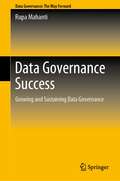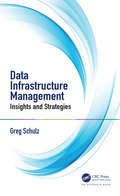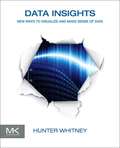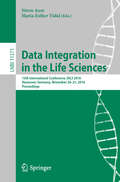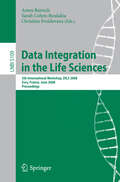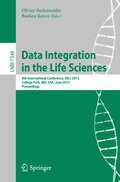- Table View
- List View
Data Governance Success: Growing and Sustaining Data Governance
by Rupa MahantiWhile good data is an enterprise asset, bad data is an enterprise liability. Data governance enables you to effectively and proactively manage data assets throughout the enterprise by providing guidance in the form of policies, standards, processes and rules and defining roles and responsibilities outlining who will do what, with respect to data. While implementing data governance is not rocket science, it is not a simple exercise. There is a lot confusion around what data governance is, and a lot of challenges in the implementation of data governance. Data governance is not a project or a one-off exercise but a journey that involves a significant amount of effort, time and investment and cultural change and a number of factors to take into consideration to achieve and sustain data governance success. Data Governance Success: Growing and Sustaining Data Governance is the third and final book in the Data Governance series and discusses the following:• Data governance perceptions and challenges • Key considerations when implementing data governance to achieve and sustain success• Strategy and data governance• Different data governance maturity frameworks• Data governance – people and process elements• Data governance metricsThis book shares the combined knowledge related to data and data governance that the author has gained over the years of working in different industrial and research programs and projects associated with data, processes, and technologies and unique perspectives of Thought Leaders and Data Experts through Interviews conducted. This book will be highly beneficial for IT students, academicians, information management and business professionals and researchers to enhance their knowledge to support and succeed in data governance implementations. This book is technology agnostic and contains a balance of concepts and examples and illustrations making it easy for the readers to understand and relate to their own specific data projects.
Data Grab: The New Colonialism of Big Tech and How to Fight Back
by Ulises A. Mejias Nick CouldryA compelling argument that the extractive practices of today’s tech giants are the continuation of colonialism—and a crucial guide to collective resistance. Large technology companies like Meta, Amazon, and Alphabet have unprecedented access to our daily lives, collecting information when we check our email, count our steps, shop online, and commute to and from work. Current events are concerning—both the changing owners (and names) of billion-dollar tech companies and regulatory concerns about artificial intelligence underscore the sweeping nature of Big Tech’s surveillance and the influence such companies hold over the people who use their apps and platforms. As trusted tech experts Ulises A. Mejias and Nick Couldry show in this eye-opening and convincing book, this vast accumulation of data is not the accidental stockpile of a fast-growing industry. Just as nations stole territories for ill-gotten minerals and crops, wealth, and dominance, tech companies steal personal data important to our lives. It’s only within the framework of colonialism, Mejias and Couldry argue, that we can comprehend the full scope of this heist. Like the land grabs of the past, today’s data grab converts our data into raw material for the generation of corporate profit against our own interests. Like historical colonialism, today’s tech corporations have engineered an extractive form of doing business that builds a new social and economic order, leads to job precarity, and degrades the environment. These methods deepen global inequality, consolidating corporate wealth in the Global North and engineering discriminatory algorithms. Promising convenience, connection, and scientific progress, tech companies enrich themselves by encouraging us to relinquish details about our personal interactions, our taste in movies or music, and even our health and medical records. Do we have any other choice? Data Grab affirms that we do. To defy this new form of colonialism we will need to learn from previous forms of resistance and work together to imagine entirely new ones. Mejias and Couldry share the stories of voters, workers, activists, and marginalized communities who have successfully opposed unscrupulous tech practices. An incisive discussion of the digital media that’s transformed our world, Data Grab is a must-read for anyone concerned about privacy, self-determination, and justice in the internet age.
Data Grab: The New Colonialism of Big Tech and How to Fight Back
by Ulises A. Mejias Nick CouldryA compelling argument that the extractive practices of today’s tech giants are the continuation of colonialism—and a crucial guide to collective resistance. Large technology companies like Meta, Amazon, and Alphabet have unprecedented access to our daily lives, collecting information when we check our email, count our steps, shop online, and commute to and from work. Current events are concerning—both the changing owners (and names) of billion-dollar tech companies and regulatory concerns about artificial intelligence underscore the sweeping nature of Big Tech’s surveillance and the influence such companies hold over the people who use their apps and platforms. As trusted tech experts Ulises A. Mejias and Nick Couldry show in this eye-opening and convincing book, this vast accumulation of data is not the accidental stockpile of a fast-growing industry. Just as nations stole territories for ill-gotten minerals and crops, wealth, and dominance, tech companies steal personal data important to our lives. It’s only within the framework of colonialism, Mejias and Couldry argue, that we can comprehend the full scope of this heist. Like the land grabs of the past, today’s data grab converts our data into raw material for the generation of corporate profit against our own interests. Like historical colonialism, today’s tech corporations have engineered an extractive form of doing business that builds a new social and economic order, leads to job precarity, and degrades the environment. These methods deepen global inequality, consolidating corporate wealth in the Global North and engineering discriminatory algorithms. Promising convenience, connection, and scientific progress, tech companies enrich themselves by encouraging us to relinquish details about our personal interactions, our taste in movies or music, and even our health and medical records. Do we have any other choice? Data Grab affirms that we do. To defy this new form of colonialism we will need to learn from previous forms of resistance and work together to imagine entirely new ones. Mejias and Couldry share the stories of voters, workers, activists, and marginalized communities who have successfully opposed unscrupulous tech practices. An incisive discussion of the digital media that’s transformed our world, Data Grab is a must-read for anyone concerned about privacy, self-determination, and justice in the internet age.
The Data Handbook: A Guide to Understanding the Organization and Visualization of Technical Data
by Brand Fortner"What our teachers don't tell us in school is that we will spend most of our scientific or engineering career in front of computers, trying to beat them into submission." This extract from the Preface sets the style for this highly readable book. It is packed with information covering data representations, the pitfalls of computer arithmetic, and a variety of widely-used representations and standards. Each chapter begins with a detailed contents list and finishes with a brief summary of the topics presented and the whole is rounded off with a glossary and index.Novices will enjoy an occasionally lighthearted read from start to finish, while even the most experienced computer users who use the book as a reference will discover useful nuggets of information.A structured array of data sets are available online via the TELOS Web site, www.telospub.com, which will provide users with direct digital access to information they might need in working through the book.
Data Hiding: Exposing Concealed Data in Multimedia, Operating Systems, Mobile Devices and Network Protocols
by Chet Hosmer Michael T. RaggoAs data hiding detection and forensic techniques have matured, people are creating more advanced stealth methods for spying, corporate espionage, terrorism, and cyber warfare all to avoid detection. Data Hiding provides an exploration into the present day and next generation of tools and techniques used in covert communications, advanced malware methods and data concealment tactics. The hiding techniques outlined include the latest technologies including mobile devices, multimedia, virtualization and others. These concepts provide corporate, goverment and military personnel with the knowledge to investigate and defend against insider threats, spy techniques, espionage, advanced malware and secret communications. By understanding the plethora of threats, you will gain an understanding of the methods to defend oneself from these threats through detection, investigation, mitigation and prevention.Provides many real-world examples of data concealment on the latest technologies including iOS, Android, VMware, MacOS X, Linux and Windows 7Dives deep into the less known approaches to data hiding, covert communications, and advanced malwareIncludes never before published information about next generation methods of data hidingOutlines a well-defined methodology for countering threatsLooks ahead at future predictions for data hiding
Data Hiding Techniques in Windows OS: A Practical Approach to Investigation and Defense
by Rami Hijazi Nihad Ahmad Hassan"This unique book delves down into the capabilities of hiding and obscuring data object within the Windows Operating System. However, one of the most noticeable and credible features of this publication is, it takes the reader from the very basics and background of data hiding techniques, and run’s on the reading-road to arrive at some of the more complex methodologies employed for concealing data object from the human eye and/or the investigation. As a practitioner in the Digital Age, I can see this book siting on the shelves of Cyber Security Professionals, and those working in the world of Digital Forensics – it is a recommended read, and is in my opinion a very valuable asset to those who are interested in the landscape of unknown unknowns. This is a book which may well help to discover more about that which is not in immediate view of the onlooker, and open up the mind to expand its imagination beyond its accepted limitations of known knowns." - John Walker, CSIRT/SOC/Cyber Threat Intelligence Specialist Featured in Digital Forensics Magazine, February 2017 In the digital world, the need to protect online communications increase as the technology behind it evolves. There are many techniques currently available to encrypt and secure our communication channels. Data hiding techniques can take data confidentiality to a new level as we can hide our secret messages in ordinary, honest-looking data files. Steganography is the science of hiding data. It has several categorizations, and each type has its own techniques in hiding. Steganography has played a vital role in secret communication during wars since the dawn of history. In recent days, few computer users successfully manage to exploit their Windows® machine to conceal their private data. Businesses also have deep concerns about misusing data hiding techniques. Many employers are amazed at how easily their valuable information can get out of their company walls. In many legal cases a disgruntled employee would successfully steal company private data despite all security measures implemented using simple digital hiding techniques. Human right activists who live in countries controlled by oppressive regimes need ways to smuggle their online communications without attracting surveillance monitoring systems, continuously scan in/out internet traffic for interesting keywords and other artifacts. The same applies to journalists and whistleblowers all over the world. Computer forensic investigators, law enforcements officers, intelligence services and IT security professionals need a guide to tell them where criminals can conceal their data in Windows® OS & multimedia files and how they can discover concealed data quickly and retrieve it in a forensic way. Data Hiding Techniques in Windows OS is a response to all these concerns. Data hiding topics are usually approached in most books using an academic method, with long math equations about how each hiding technique algorithm works behind the scene, and are usually targeted at people who work in the academic arenas. This book teaches professionals and end users alike how they can hide their data and discover the hidden ones using a variety of ways under the most commonly used operating system on earth, Windows®.
Data in Context: Models as Enablers for Managing and Using Data (The Enterprise Engineering Series)
by Bas van GilsData is an increasingly important asset for many organizations. This book shows how to model data in a way that allows to exploit this asset effectively and in every respect. To this end, it combines and exploits scientific (semiotics, relational model, etc.) and pragmatic theories (most prominently: the DAMA wheel) and provides a coherent overview from a business and an IT/ICT perspective.After a brief introduction, the remaining book consists of three parts. In Part I “Data”, the focus is on understanding data. It includes theories in semiotics, the relational model, and normalization, as well as related theories around understanding data/designing sound data structures. This part is complemented by an extensive chapter on how to design effective data structures and a smaller one on the topic of create versus use context. Part II “Data Management” then focuses on managing data as an asset. This part is based on the DMBOK and each of the functional areas is discussed in a separate chapter. Part III “Parting Thoughts” presents conclusions which are based on a synthesis of Part I and Part II, leading up to a summary of the main contributions of this book as well as a critical reflection on these results.This book is written for a rather broad audience, ranging from professionals to students, both from business, computer science, and information management. The writing style is adjusted specifically for these groups. At the end of each chapter reflection questions are included that distinguish between questions for practitioners and for students and help both audiences to benefit from the book and check their comprehension.
Data, Information, and Time: The DIT Model (SpringerBriefs in Computer Science)
by Hermann KopetzThis SpringerBrief presents the data- information-and-time (DIT) model that precisely clarifies the semantics behind the terms data, information and their relations to the passage of real time. According to the DIT model a data item is a symbol that appears as a pattern (e.g., visual, sound, gesture, or any bit pattern) in physical space. It is generated by a human or a machine in the current contextual situation and is linked to a concept in the human mind or a set of operations of a machine. An information item delivers the sense or the idea that a human mind extracts out of a given natural language proposition that contains meaningful data items. Since the given tangible, intangible and temporal context are part of the explanation of a data item, a change of context can have an effect on the meaning of data and the sense of a proposition. The DIT model provides a framework to show how the flow of time can change the truth-value of a proposition. This book compares our notions of data, information, and time in differing contexts: in human communication, in the operation of a computer system and in a biological system. In the final Section a few simple examples demonstrate how the lessons learned from the DIT-model can help to improve the design of a computer system.
Data Infrastructure Management: Insights and Strategies
by Greg SchulzThis book looks at various application and data demand drivers, along with data infrastructure options from legacy on premise, public cloud, hybrid, software-defined data center (SDDC), software data infrastructure (SDI), container as well as serverless along with infrastructure as a Service (IaaS), IT as a Service (ITaaS) along with related technology, trends, tools, techniques and strategies. Filled with example scenarios, tips and strategy considerations, the book covers frequently asked questions and answers to aid strategy as well as decision-making.
Data Infrastructure Management: Insights and Strategies
by Greg SchulzThis book looks at various application and data demand drivers, along with data infrastructure options from legacy on premise, public cloud, hybrid, software-defined data center (SDDC), software data infrastructure (SDI), container as well as serverless along with infrastructure as a Service (IaaS), IT as a Service (ITaaS) along with related technology, trends, tools, techniques and strategies. Filled with example scenarios, tips and strategy considerations, the book covers frequently asked questions and answers to aid strategy as well as decision-making.
Data Insights: New Ways to Visualize and Make Sense of Data
by Hunter WhitneyData Insights: New Ways to Visualize and Make Sense of Data offers thought-provoking insights into how visualization can foster a clearer and more comprehensive understanding of data. The book offers perspectives from people with different backgrounds, including data scientists, statisticians, painters, and writers. It argues that all data is useless, or misleading, if we do not know what it means. Organized into seven chapters, the book explores some of the ways that data visualization and other emerging approaches can make data meaningful and therefore useful. It also discusses some fundamental ideas and basic questions in the data lifecycle; the process of interactions between people, data, and displays that lead to better questions and more useful answers; and the fundamentals, origins, and purposes of the basic building blocks that are used in data visualization. The reader is introduced to tried and true approaches to understanding users in the context of user interface design, how communications can get distorted, and how data visualization is related to thinking machines. Finally, the book looks at the future of data visualization by assessing its strengths and weaknesses. Case studies from business analytics, healthcare, network monitoring, security, and games, among others, as well as illustrations, thought-provoking quotes, and real-world examples are included. This book will prove useful to computer professionals, technical marketing professionals, content strategists, Web and product designers, and researchers.Demonstrates, with a variety of case studies, how visualizations can foster a clearer and more comprehensive understanding of data Answers the question, "How can data visualization help me?" with discussions of how it fits into a wide array of purposes and situations Makes the case that data visualization is not just about technology; it also involves a deeply human process
Data Integration: The Relational Logic Approach (Synthesis Lectures on Artificial Intelligence and Machine Learning)
by Michael MorrisData integration is a critical problem in our increasingly interconnected but inevitably heterogeneous world. There are numerous data sources available in organizational databases and on public information systems like the World Wide Web. Not surprisingly, the sources often use different vocabularies and different data structures, being created, as they are, by different people, at different times, for different purposes. The goal of data integration is to provide programmatic and human users with integrated access to multiple, heterogeneous data sources, giving each user the illusion of a single, homogeneous database designed for his or her specific need. The good news is that, in many cases, the data integration process can be automated. This book is an introduction to the problem of data integration and a rigorous account of one of the leading approaches to solving this problem, viz., the relational logic approach. Relational logic provides a theoretical framework for discussing data integration. Moreover, in many important cases, it provides algorithms for solving the problem in a computationally practical way. In many respects, relational logic does for data integration what relational algebra did for database theory several decades ago. A companion web site provides interactive demonstrations of the algorithms. Table of Contents: Preface / Interactive Edition / Introduction / Basic Concepts / Query Folding / Query Planning / Master Schema Management / Appendix / References / Index / Author Biography Don't have access? Recommend our Synthesis Digital Library to your library or purchase a personal subscription. Email info@morganclaypool.com for details.
Data Integration in the Life Sciences: 11th International Conference, DILS 2015, Los Angeles, CA, USA, July 9-10, 2015, Proceedings (Lecture Notes in Computer Science #9162)
by Naveen Ashish Jose-Luis AmbiteThis book constitutes the proceedings of the 11th International Conference on Data Integration in the Life Sciences, DILS 2015, held in Los Angeles, CA, USA, in July 2015. The 24 papers presented in this volume were carefully reviewed and selected from 40 submissions. They are organized in topical sections named: data integration technologies; ontology and knowledge engineering for data integration; biomedical data standards and coding; medical research applications; and graduate student consortium.
Data Integration in the Life Sciences: 13th International Conference, DILS 2018, Hannover, Germany, November 20-21, 2018, Proceedings (Lecture Notes in Computer Science #11371)
by Sören Auer Maria-Esther VidalThis book constitutes revised selected papers from the 13th International Conference on Data Integration in the Life Sciences, DILS 2018, held in Hannover, Germany, in November 2018.The 5 full, 8 short, 3 poster and 4 demo papers presented in this volume were carefully reviewed and selected from 22 submissions. The papers are organized in topical sections named: big biomedical data integration and management; data exploration in the life sciences; biomedical data analytics; and big biomedical applications.
Data Integration in the Life Sciences: 5th International Workshop, DILS 2008, Evry, France, June 25-27, 2008, Proceedings (Lecture Notes in Computer Science #5109)
by Amos Bairoch Sarah Cohen-Boulakia Christine FroidevauxFor several years now, there has been an exponential growth of the amount of life science data (e. g. , sequenced complete genomes, 3D structures, DNA chips, mass spectroscopy data), most of which are generated by high-throughput - periments. This exponentialcorpusof data is storedand made availablethrough a large number of databases and resources over the Web, but unfortunately still with a high degreeof semantic heterogeneity and varying levels of quality. These data must be combined together and processed by bioinformatics tools deployed on powerful and e?cient platforms to permit the uncovering of patterns, s- ilarities and in general to help in the process of discovery. Analyzing complex, voluminous, and heterogeneous data and guiding the analysis of data are thus of paramount importance and necessitate the involvement of data integration techniques. DILS 2008 was the ?fth in a workshop series that aims at fostering disc- sion, exchange, and innovation in research and development in the area of data integration for the life sciences. Each previous DILS workshop attracted around 100 researchers from all over the world and saw an increase of submitted - pers over the preceding one. This year was not an exception and the number of submitted papers increased to 54. The ProgramCommittee selected 18 of them. The selected papers cover a wide spectrum of theoretical and practical issues including data annotation, Semantic Web for the life sciences, and data mining on integrated biological data.
Data Integration in the Life Sciences: 9th International Conference, DILS 2013, Montreal, Canada, July 11-12, 2013, Proceedings (Lecture Notes in Computer Science #7970)
by Christopher J. O. Baker Greg Butler Igor JurisicaThis book constitutes the refereed proceedings of the 9th International Conference on Data Integration in the Life Sciences, DILS 2013, held in Montreal, QC, Canada, in July 2013. The 10 revised papers included in this volume were carefully reviewed and selected from 23 submissions. The papers cover a range of important topics such as algorithms for ontology matching, interoperable frameworks for text mining using semantic web services, pipelines for genome-wide functional annotation, automation of pipelines providing data discovery and access to distributed resources, knowledge-driven querying-answer systems, prizms, nanopublications, electronic health records and linked data.
Data Integration in the Life Sciences: 8th International Conference, DILS 2012, College Park, MD, USA, June 28-29, 2012, Proceedings (Lecture Notes in Computer Science #7348)
by Olivier Bodenreider Bastien RanceThis book constitutes the refereed proceedings of the 8th International Conference on Data Integration in the Life Sciences, DILS 2012, held in College Park, MD, USA, on June 28-29, 2012. The 11 revised papers included in this volume were carefully reviewed and selected. The papers cover the following topics: foundations of data integration, new paradigms for data integration, and integrating clinical data.
Data Integration in the Life Sciences: 4th International Workshop, DILS 2007, Philadelphia, PA, USA, June 27-29, 2007, Proceedings (Lecture Notes in Computer Science #4544)
by Sarah Cohen-Boulakia Val TannenThis book constitutes the refereed proceedings of the 4th International Workshop on Data Integration in the Life Sciences, DILS 2007, held in Philadelphia, PA, USA in July 2007. It covers new architectures and experience on using systems, managing and designing scientific workflows, mapping and matching techniques, modeling of life science data, and annotation in data integration.
Data Integration in the Life Sciences: 10th International Conference, DILS 2014, Lisbon, Portugal, July 17-18, 2014. Proceedings (Lecture Notes in Computer Science #8574)
by Helena Galhardas Erhard RahmThis book constitutes the refereed proceedings of the 10th International Conference on Data Integration in the Life Sciences, DILS 2014, held in Lisbon, Portugal, in July 2014. The 9 revised full papers and the 5 short papers included in this volume were carefully reviewed and selected from 20 submissions. The papers cover a range of important topics such as data integration platforms and applications; biodiversity data management; ontologies and visualization; linked data and query processing.
Data Integration in the Life Sciences: 7th International Conference, DILS 2010, Gothenburg, Sweden, August 25-27, 2010. Proceedings (Lecture Notes in Computer Science #6254)
by Patrick Lambrix Graham KempThe development and increasingly widespread deployment of high-throughput experimental methods in the life sciences is giving rise to numerous large, c- plex and valuable data resources. This foundation of experimental data und- pins the systematic study of organismsand diseases, which increasinglydepends on the development of models of biological systems. The development of these models often requires integration of diverse experimental data resources; once constructed, the models themselves become data and present new integration challenges for tasks such as interpretation, validation and comparison. The Data Integration in the Life Sciences (DILS) Conference series brings together data and knowledge management researchers from the computer s- ence research community with bioinformaticians and computational biologists, to improve the understanding of how emerging data integration techniques can address requirements identi?ed in the life sciences. DILS 2010 was the seventh event in the series and was held in Goth- burg, Sweden during August 25–27, 2010. The associated proceedings contain 14 peer-reviewed papers and 2 invited papers. The sessions addressed ontology engineering, and in particular, evolution, matching and debugging of ontologies, akeycomponentforsemanticintegration;Web servicesasanimportanttechn- ogy for data integration in the life sciences; data and text mining techniques for discovering and recognizing biomedical entities and relationships between these entities; and information management, introducing data integration solutions for di?erent types of applications related to cancer, systems biology and - croarray experimental data, and an approach for integrating ranked data in the life sciences.
Data Integration in the Life Sciences: Third International Workshop, DILS 2006, Hinxton, UK, July 20-22, 2006, Proceedings (Lecture Notes in Computer Science #4075)
by Ulf Leser Felix Naumann Barbara EckmanThis book constitutes the refereed proceedings of the Third International Workshop on Data Integration in the Life Sciences, DILS 2006, held in Hinxton, UK in July 2006. Presents 19 revised full papers and 4 revised short papers together with 2 keynote talks, addressing current issues in data integration from the life science point of view. The papers are organized in topical sections on data integration, text mining, systems, and workflow.
Data Integration in the Life Sciences: Second International Workshop, DILS 2005, San Diego, CA, USA, July 20-22, 2005, Proceedings (Lecture Notes in Computer Science #3615)
by Bertram Ludäscher Louiqa RaschidData Integration in the Life Sciences: 6th International Workshop, DILS 2009, Manchester, UK, July 20-22, 2009, Proceedings (Lecture Notes in Computer Science #5647)
by Norman W. Paton Paolo Missier Cornelia HedelerData integration in the life sciences continues to be important but challe- ing. The ongoing development of new experimental methods gives rise to an increasingly wide range of data sets, which in turn must be combined to allow more integrative views of biological systems. Indeed, the growing prominence of systems biology, where mathematical models characterize behaviors observed in experiments of di?erent types, emphasizes the importance of data integration to the life sciences. In this context, the representation of models of biological behavior as data in turn gives rise to challenges relating to provenance, data quality, annotation, etc., all of which are associated with signi?cant research activities within computer science. The Data Integration in the Life Sciences (DILS) Workshop Series brings together data and knowledge management researchers from the computer s- ence research community with bioinformaticians and computational biologists, to improve the understanding of how emerging data integration techniques can address requirements identi?ed in the life sciences.
Data Integration in the Life Sciences: First International Workshop, DILS 2004, Leipzig, Germany, March 25-26, 2004, proceedings (Lecture Notes in Computer Science #2994)
by Erhard RahmData Integration in the Life Sciences: 12th International Conference, DILS 2017, Luxembourg, Luxembourg, November 14-15, 2017, Proceedings (Lecture Notes in Computer Science #10649)
by Marcos Da Silveira Cédric Pruski Reinhard SchneiderThis book constitutes the proceedings of the 12th International Conference on Data Integration in the Life Sciences, DILS 2017, held in Luxembourg, in November 2017. The 5 full papers and 5 short papers presented in this volume were carefully reviewed and selected from 16 submissions. They cover topics such as: life science data modelling; analysing, indexing, and querying life sciences datasets; annotating, matching, and sharing life sciences datasets; privacy and provenance of life sciences datasets.
